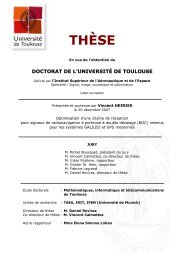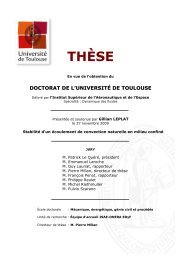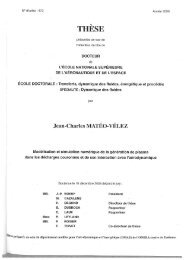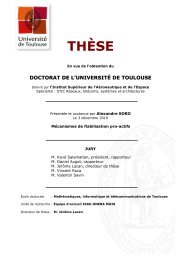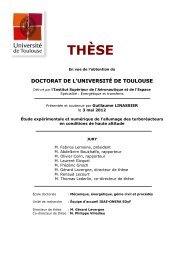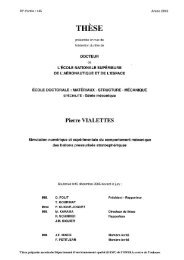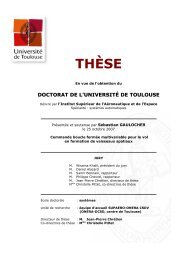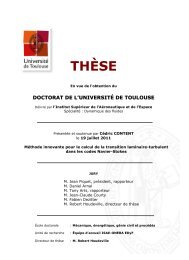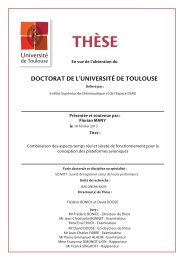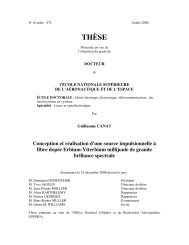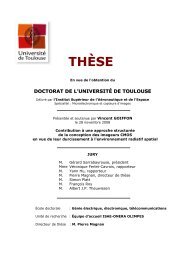Simulation numérique directe de la turbulence en présence d ... - ISAE
Simulation numérique directe de la turbulence en présence d ... - ISAE
Simulation numérique directe de la turbulence en présence d ... - ISAE
You also want an ePaper? Increase the reach of your titles
YUMPU automatically turns print PDFs into web optimized ePapers that Google loves.
Chapitre 3. Prés<strong>en</strong>tation du co<strong>de</strong> EVEREST 87<br />
(a) Spectre PP<br />
(b) Spectre VKP<br />
Figure 3.11 – Champs initiaux <strong>de</strong>s vorticités pour les spectres PP et VKP<br />
<strong>de</strong> dérivation continue s’écriv<strong>en</strong>t :<br />
df<br />
dx (x i) =<br />
d 2 f<br />
dx 2 (x i) =<br />
N/2−1<br />
∑<br />
κ=−N/2<br />
N/2−1<br />
∑<br />
κ=−N/2<br />
jk ˆf κ exp(jx i κ) (3.33)<br />
−κ 2 ˆfκ exp(jx i κ) (3.34)<br />
Le schéma <strong>de</strong> dérivation donne une valeur approchée <strong>de</strong>s dérivées <strong>de</strong> f. Ainsi, les dérivées<br />
premières et secon<strong>de</strong>s s’écriv<strong>en</strong>t :<br />
df<br />
dx (x i) ≈ f ′ i =<br />
d 2 f<br />
dx 2 (x i) ≈ f ′′<br />
i =<br />
N/2−1<br />
∑<br />
κ=−N/2<br />
N/2−1<br />
∑<br />
κ=−N/2<br />
jκ ′ (ω κ ) ˆf κ exp(jx i κ) (3.35)<br />
−κ ′′ (ω κ ) ˆf κ exp(jx i κ) (3.36)<br />
où ω κ = κ∆x est <strong>la</strong> pulsation associée au nombre d’on<strong>de</strong> κ. Ces expressions font apparaître<br />
les nombres d’on<strong>de</strong> modifiés κ ′ et κ ′′ . Le pouvoir <strong>de</strong> résolution est défini grâce aux pulsations<br />
modifiées :<br />
ω ′ (ω κ ) = ∆xk ′ (ω κ ) ; ω ′′ (ω κ ) = (∆x) 2 k ′′ (ω κ )<br />
D’après Lele [15], pour le schéma compact <strong>de</strong> dérivation première, <strong>la</strong> pulsation modifiée s’écrit :<br />
ω ′ (ω κ ) = a sin(ω κ) + (b/2) sin(2ω κ ) + (c/3) sin(3ω κ )<br />
1 + 2α cos(ω κ ) + 2β cos(2ω κ )<br />
(3.37)<br />
Le nombre d’on<strong>de</strong> maximal résolu correspond à l’extrémité <strong>de</strong> <strong>la</strong> zone dans <strong>la</strong>quelle κ ′ = κ + ɛ<br />
(ou ω ′ (ω κ ) = ω κ + ɛ) avec ɛ le niveau d’écart toléré vérifiant <strong>la</strong> re<strong>la</strong>tion :<br />
ω ′ − ω<br />
∣ ω ∣ ≤ ɛ (3.38)



